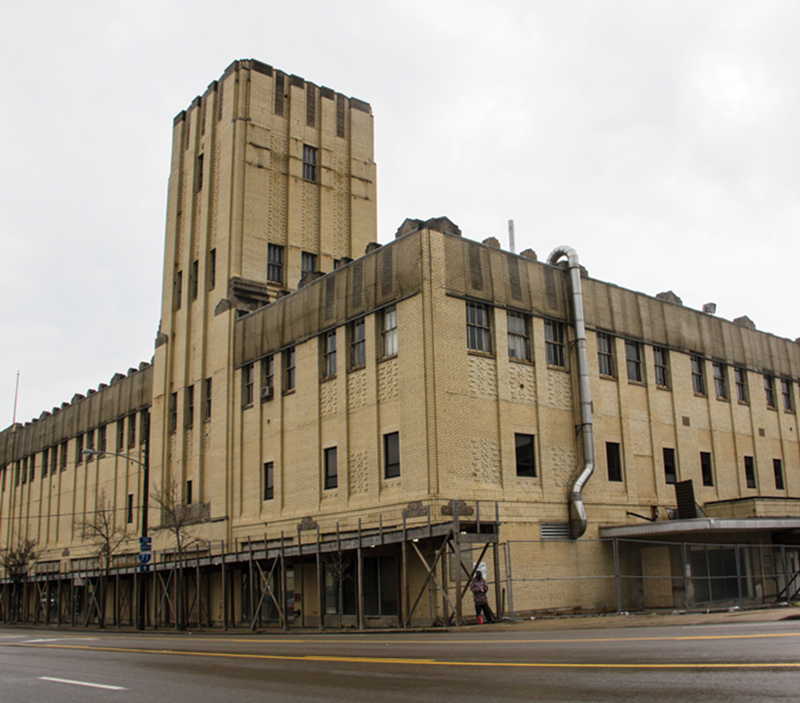I
magine a classic 1920s storefront window complete with mannequins posed in their finery. Now imagine a new type of display — a space filled with buzzing drones, giant 3D printers and announcements of the latest medical breakthroughs. Welcome to the dichotomy soon to be known as of the University of Cincinnati’s new innovation center.
University trustees recently approved $16 million in funding to transform Cincinnati’s first Sears, Roebuck & Company department store building into a research accelerator. The Art Deco style structure, originally constructed in 1929, most recently served as UC’s Campus Services Building. The facility is expected to be an innovative showcase, attracting researchers from the university, the city and beyond.
“The way I sometimes think of it is when someone’s trying to build a new community, they’ll have the model home,” says William Ball, vice president for research at UC. “They’ll have a place where everyone can come and see what the city and this whole region has to offer.”
According to Ball, the building will be ready for occupancy within 18 months, with the first tenant expected to be the independent, nonprofit University of Cincinnati Research Institute (UCRI). While the new innovation center will provide an ideal transition for UC-born research startups, Ball emphasizes the facility will act as an “innovation zone,” attracting researchers from a variety of sources and fostering partnerships. While the exact details for the space are still fluid, Ball says the goal of the project is to allow occupants to share resources and information within the space.
“Our concept today is that the university will only be as strong as the economic viability of the community in which it lies,” Ball says. “We could have turned it into an academic building and just held classes — but here’s an opportunity where the university can help contribute to the economic viability of the region.”
Another purpose for the innovation center will be to draw a spotlight to other area innovators including the Cincinnati Zoo, UC Health, Children’s Hospital, Proctor & Gamble and G.E. Aviation to name a few, Ball says. In addition to actual research, he sees the facility as a marketing tool to bring in outside industry. He says the building might contain meeting rooms where companies could offer consulting services such as UC’s Lindner College of Business, College of Engineering or the College of Design, Architecture, Art and Planning (DAAP).
“We’re having discussions with different groups and different entities to sell them on the idea of potentially locating to this space in some way,” he says. “The whole concept design of how it will end up and how it will flow is under early development. We are putting together a group who will better define specifically exactly how things will work within this building.”
Located at 2900 Reading Road, the former Sears building occupies prime real estate in relation to the upcoming $80 million Martin Luther King/I-71 interchange project. Uptown Consortium CEO Beth Robinson says the UC renovation marks the first major redevelopment of the corridor. She describes the project as integral to their vision of a revitalized gateway dominated by accelerators, research labs and offices.
“It’s a welcome addition because it fits in with the vision of creating an innovation corridor,” Robinson says. “There’s definitely opportunity and with the interchange coming in, those opportunities become more prominent as more and more people see the progress and the vision.”
The Consortium consists of members from Children’s Hospital, the Cincinnati Zoo, TriHealth, UC Health and University of Cincinnati and strives for economic sustainability in its neighborhoods, including Avondale, Clifton, Corryville, Clifton Heights, Fairview, University Heights and Mount Auburn. While their focus is on business development, Robinson says they never lose sight of community inclusion and nurturing the diversity of their neighborhoods.
“It’s really exciting that they’re restoring the building instead of demolishing it,” Robinson says. “It was an important part of the Reading Road history. That store was part of the fabric of Reading Road for many years and so I just think it’s a very desirable thing to do.”
As with many historic buildings, two inevitable options arise: restoration or demolition. As for the Sears building, Ball says UC architect Beth McGrew proposed repurposing the structure based on its solid construction; she refers to it as a “building with great bones.” Her initial plans call for minimal demolition, preserving the majority of the original historic façade, which includes more than 133,000 square-feet of space amid three floors and a basement.
“Instead of tearing the building down, which is where we were headed, I thought we might preserve the structure and some parts of the façade and use an existing building rather than starting from scratch,” McGraw says. “It was already near the interchange, it met all the criteria, so I thought this might be a good path. We put together a few conceptual ideas and the university agreed it met our mission.”
Renovation came in at a fraction of the cost of a new building, McGrew explains. She says the Chicago architectural firm Nimmons, Carr & Wright took great care with both the aesthetics in design and sustainability back in the late 1920s while erecting the structure.
“It also has deep footings, which may not sound so interesting, but in Ohio with our geology it’s a bonus to have a deep foundation that we don’t have to worry about differential settlement,” she says. “And clearly a building that old that doesn’t show any now isn’t going anywhere.”
As for the interior space, McGrew says the design will be contingent on tenant’s needs. As the building will feature cutting-edge research, Ball says he expects the building itself to be a technological showplace. In addition to its prime location, he says the innovation center will be part of Ohio’s $8.1 million 100 gigabit Internet network, allowing tenants to network at breakneck speeds.
Ball envisions the classic storefront windows filled with exciting examples of innovation. He expects the center to both impress and entice innovators.
“Who knows what will happen — you might see a few unmanned vehicles floating around delivering things across the building,” he says. “Especially with DAAP involved, believe me, it probably will be something futuristic.” ©






